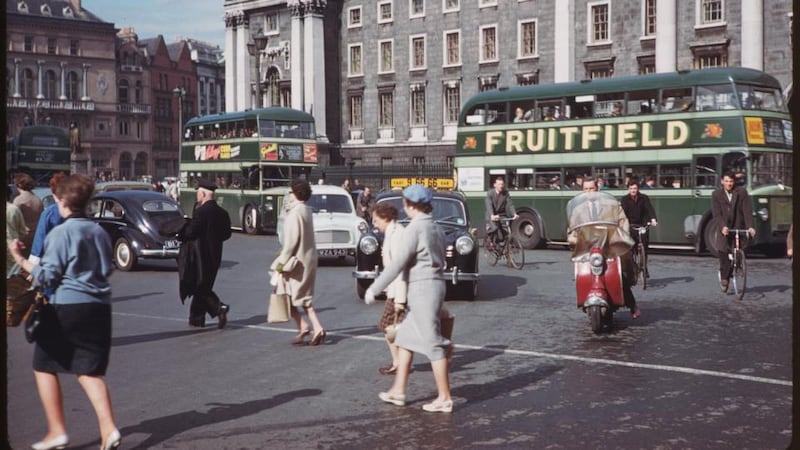Chances are if you close your eyes and picture the Dublin of the 1950s and 1960s, the images that will come to mind are in black and white. Gritty streets, shadows, cobblestones, grey raincoats and gradated light, filtered through the smoke of coal fires from every chimney.
These are the prevailing images of the period from its best photographers, Colman Doyle, Fergus Bourke and Bill Doyle, and the painter Nevill Johnson, whose superb book – Dublin: The People's City – of black and white photographs of Dublin taken in 1952/53 stick in the unconscious in proud monochrome.
Colour had, in fact, been around since the turn of the century. In 1913 two French women, Madelaine Mignon-Alba and Marguerite Mespoulet, toured Ireland and took what are believed to be the first set of colour images of the country using the Lumiere-Autochrome process.
Rural life
The pair avoided Dublin and documented rural life, mainly in the west of the country.


By 1967, the German photographer Evelyn Hofer took another famous set of images, many in colour, for her travel book Dublin – A Portrait with the writer VS Pritchett.
Six years earlier, American surveyor Charles Cushman visited Dublin and took a set of images using Kodachrome slide film. These images have resurfaced thanks to the University of Indiana, which has acquired Cushman's entire collection of images, including 14,400 colour slides taken on his travels.
Cushman, who died in 1970, was born in 1896 in Poseyville, Indiana, to relatively well-off parents. He studied at the university which has now acquired his collection and became a surveyor by profession. A keen amateur, he became interested in photography and took photographs on his travels, a practice he continued into retirement, amassing a set of slides to entertain family and friends.
The great bulk of his photographs were taken in the US and represents a rare colour street photography document from 1938 onwards.
Tomorrow Cushman’s images of Dublin go on display at the Little Museum of Dublin on St Stephen’s Green. Most of the images were taken in the areas around Dame Street, College Green and O’Connell Street. While the pictures are not on an aesthetic par with those of Hofer, they are nonetheless fascinating.
Here is a Dublin of buses, cyclists, scooters and dray-horse men. But the buses are green, the wheels of the horse-carts a cheerful orange, the fashions pink, or blue, or transparent Macintosh.
Smokes while cycling
Alongside the heavy-coated cyclists are young guys with Teddy-boy cuts, and mods with reddish scooters. A man on a bicycle wears a hat rather than helmet and smokes while cycling. The Kodachrome colour, as good as it got for most of its history, remains solid if muted, though it is always hard to know to what extent inevitable fading over time has on colour.
Younger viewers may be best acquainted with these colour values through Instagram-type filters. The signs and the advertising slogans are fascinating – a Garda sign on a squad car, a bus sign in the older Irish script, a red Caltex (now Texaco) sign and a Guinness sign decorating buses.
Cushman’s photographs are mainly of street scenes and he appeared keen to capture the contrast between the dray carts and the buses and cars, perhaps conscious of a world which was quickly vanishing.
The exhibition continues into March.







